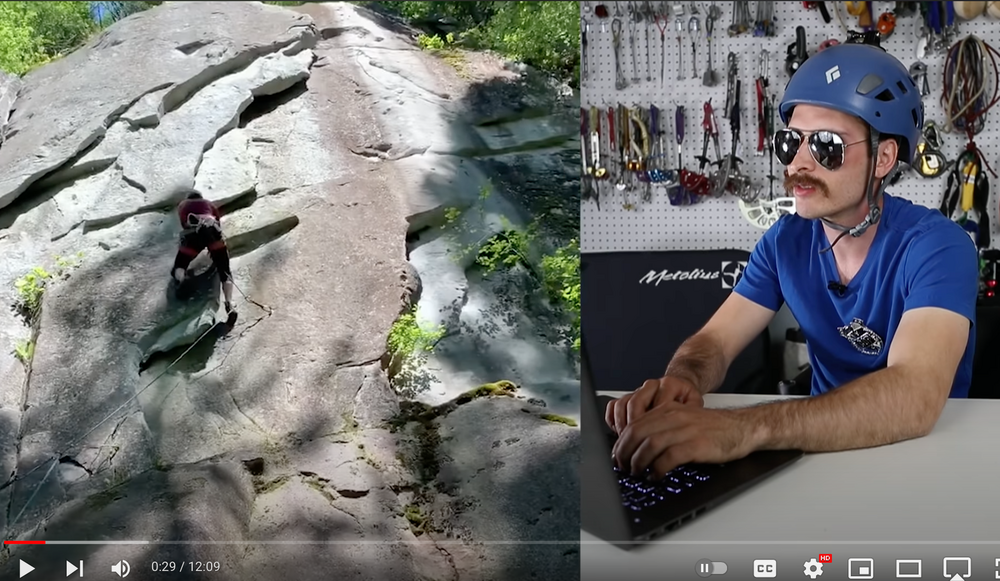How do you avoid backstepping in this situation?
|
|
source: https://www.youtube.com/watch?v=_gLuJuB6dEk If your feet are to the left of the climber's strand, you're backstepping the belayer's strand , but if your feet are to the right of the climber's strand, you are obviously backstepping that strand. I was thinking that you could extend the piece, but that might not be a good idea if you have a ledge below you, like it seems in this situation. And also that doesn't change the fact that you would just be backstepping the sling if your feet are on the right! Seems like this is just one of those shitty situations where you should be wearing your helmet? Edit: Thanks to Slim for their answer! I like the idea of having two climber's strands to manage the sharp corner in the rope (European style I presume), one for the traverse, and one for going up. slimwrote: A couple of people complained about bolting, or gear placement, but looks to me like the flakes to the left are pretty chossy and may be why the bolt is far right in the more bomber part of the wall. And if the gear is bad and scarce, or are worried about decking or hitting a ledge on a multi, as I mention above, it's not too helpful to think about extending or back cleaning. |
|
|
To get the pedantic out of the way, back stepping is a climbing technique and has nothing to do with the rope, though apparently many gyms are teaching it as a term that refers to having your leg behind the rope. Next, there is no reason that the climber couldn’t have their leg on the other side of the rope in this case. Last, it’s always a good idea to wear your helmet. |
|
|
anonymous cowardwrote: No reason? If you can't visualize the situation, then press on the link. Dude flips upside down and smacks into the wall. His right foot is clearly backstepped (you didn't provide an alternate term, so I'll just keep using it) and in the video his right foot, to the right of the rope, catches the strand after the draw, and his left foot catches the strand below the draw. |
|
|
Sorry, it's not called "backstepping." You could call it "rope behind the leg," if you want. Edit: Why are you wearing a helmet indoors, while working on a keyboard? |
|
|
Redacted Redactbergwrote: The point was that it was avoidable, not that it couldn’t happen. The solution is to make sure your leg is outside the rope, by moving it outside the rope. |
|
|
FrankPSwrote: Whether you like it or not, seems prevalent enough. Language evolves, and people call things differently in diverse parts of the world. You can either be old and crusty about it and shake your fists at the clouds, or just accept that it's in the vernacular. |
|
|
Redacted Redactbergwrote: Wait, you're saying that thread concluded it is called "backstepping"? You can call it what you want, but it was far from unanimous in that thread. Maybe that's what gym climbers are calling it, but that's not what it's called outdoors. Signed, Old and Crusty. |
|
|
David- sorry you can’t change out a word that already has meaning, especially something from “the gym”. And you really are if you can’t figure it out. Call me old and crusty if you wish. Later, all the best to you. |
|
|
Despite being middle-aged, crusty and a strict constructionist re: vertical vernacular, I will endeavor to give you a straight answer, David. It would be possible to pull those moves without rope/leg interference, but the ropeline from his first gear placements makes for quite the sticky spiderweb. He would've done well to backclean those pieces from the ledge after clipping the bolt (and perhaps backing it up). I haven't climbed the route, so YMMV. |
|
|
Redacted Redactbergwrote: The simple solution in this case is to have your right foot BELOW the lower strand (and obviously no leg behind the rope). You’d probably have to lift the rope a bit with your foot. And yes I think extending the last piece would help |
|
|
The belay was so tight my gosh that rope would have tripped up anyone. |
|
|
Sometimes it is helpful to realize this is going to be a problem from below (if possible). For this situation something that could help is tying into both ends of the rope and using them like doubles. Left strand basically gets you up to the bolt, and keep going with the right strand. If it straightens out after thjs and you can ge to a stance you can untie and drop the left rope if need be (ie if pitch is longer than half a rope length). I dont really think a more slack belay would help. would just the traversing strand under him a bigger floppier loop. |
|
|
Artem Vee wrote: “Watch the rope” is exactly the same amount of syllables and does not conflate an already accepted term. Before this thread, somebody would literally have had to explain to me with a small paragraph what they meant by “backstepping” in the sense you mean. So, no, “we” did not all get what he was saying. Sure, if all “you” get that you’re talking about a safety issue versus a technique issue, then within that context it’s fine. If you’re shouting ambiguous gibberish at old crusty psychos like me while I climb, maybe it’s not so helpful. Then again, if you’re always backstepping the rope, maybe you need all the shorthand you can get. I bet it could be shortened further for those who truly can’t manage to remember the concept. |
|
|
Artem Vee wrote: I’m so confused. Please, explain to me more how language changes, cat daddy. I can’t wait until I’m at the crag hearing a harmonized chorus of idiots chanting “Backstepping, brah!” and me, a veritable cave man, will now know what they mean. Imagine my astonishment! |
|
|
Couldn't that line have been protected more thoughtfully? |
|
|
Redacted Redactbergwrote: It’s not “back stepping”, it’s “leg behind rope”. This is the dumbest thing to come out of the gyms since belay glasses. There’s no universal fix besides using your brain, in this particular case extending might help. Congrats on 100k views! |
|
|
I'm picturing David and Artem as potential partners. I believe the route should have started directly below the bolt, not from the side. Or it's a one star climb. Thanks for the vid though, well done and funny, hollow coconuts is my favorite line. |
|
|
It's flark. |
|
|
This is my giraffe. If you refer to this as a dog, you are old and crusty. It's a giraffe. Language evolves. |
|
|
FrankPSwrote:
|
|
|
FrankPSwrote: Don’t go on urban dictionary or ever use the internet, or interact with anyone below the age if 50. You’re gonna get really pissed all the time. You will see people using words in ways you’ve never seen before. Edit: I’d also add don’t ever travel outside the US to climb, as you will me mad too. Even the canadians and brits call things differently and use different commands. |

 Continue with onX Maps
Continue with onX Maps Sign in with Facebook
Sign in with Facebook


























